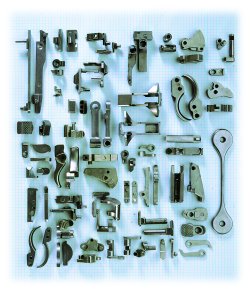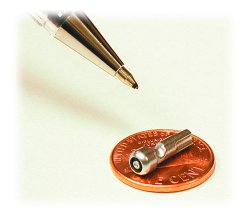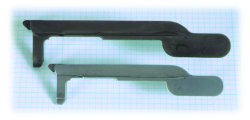|
This process produces high-quality finished metal parts by molding metal alloy powder as if it were plastic. When you spend as much time at trade shows as some of us do, everything starts to look so familiar; and you long to see something really different. This past September, while at the Detroit APEX Show, I spotted a counter full of small, complex parts that looked rather unique. They were not stamped or machined. I asked, “How did you do this?” The booth manager, Eduardo Lopes de Barros, the general manager of Taurus International Manufacturing, Inc. (Miami, FL), explained the process, how he came to use it, and why he prefers it to traditional machining methods.
The small parts had been produced using a process called metal injection molding (MIM). MIM combines two proven processes: plastic injection molding and high density sintering. The process molds metal alloy as if it were plastic. As it turns out, MIM has been around for as long as 15 years. However, not until recently has the process really been refined to the point that parts can be made cost-effectively using today’s high-quality steels. Ideal MIM Candidates The MIM process is ideal for the production of relatively small (from 1 – 50 grams), complex-shaped metal components with tight tolerance, high strength, and good surface finish requirements — exactly the type of parts produced by Taurus, whose largest customer is the company’s parent operation in Brazil, a manufacturer of firearms. Consequently, the various parts need to be strong enough to withstand the pressures that develop when firing a handgun. Taurus was purchasing many of these parts as machined items or investment castings until it discovered the MIM process. Of the 60 or so parts that make up a typical handgun, Taurus now produces an average of seven parts for each gun using the MIM process. DeBarros switched to MIM because many small, intricate parts cannot be produced using traditional machining; or, if they can be machined, the process is so extensive that it becomes prohibitively expensive. Other parts can be investment cast, but these require secondary operations, such as machining to add features and polishing to improve surface finish. The MIM process, however, provides great flexibility in terms of part design, shape, and features. MIM parts are near net shape without requiring secondary operations; they are 95% - 100% dense, depending on the alloy; and they have a 32 RMS finish. DeBarros reports that he is able to maintain tolerances of 0.005" per inch and high consistency between parts.
One part that DeBarros designed specifically for the MIM process is a safety lock for a Taurus gun. The complexity of the part illustrates why MIM is the only practical way to produce it. The part has a shaft, a helix on the outside, two exterior slots, a 0.180" diameter head, an internal diameter of 0.118", and a hex that runs to the center with a 0.040" diameter pin in the center. There are about 40 different dimensions. EDM (electrical discharge machining) is the only traditional machining process that can produce this part. However, MIM is the only practical, economically feasible method of producing 240,000 of these parts annually. DeBarros cites cost reduction as another advantage of the MIM process. “The savings are quite big if you have a complex part,” he says. “The more complex the part, the more competitive it is. That’s because once you design and develop the mold, you can run one or two million parts. On the other hand, it is not competitive with simple parts that can be produced by screw machines, conventional PM or die casting.” The MIM process is not just for steels, either. It allows for a wide selection of metal alloys, including stainless steel, alloy steels, tool steels, brass, copper, titanium, tungsten, ceramics, and many special alloys such as ASTM F17 nickel-free stainless steel. Process Description MIM processing starts by blending very fine metal powders, about four microns in size, and plastic binders. This mixture, which consists of elemental iron powder and various powdered alloys that will form the part, is referred to as feedstock. The feedstock is fed to the die of the injection molding machine at pressures up to 2,300 psi where the melting plastic carries the metal alloy into the die cavities. Molds are designed to be gated off allowing the feedstock to enter any number of chambers in the mold. Gate locations permit the feedstock to flow from thick to thin sections as it enters the die. One mold produces several identical parts.
When the “green” parts come out of the mold, they are brittle and noticeably oversized compared with the end product. That is because the parts still have binders holding the powdered metal in solution, with each grain of metal coated with binder. Next, a two-step process removes the binders. First, the parts are immersed in a heated solvent solution to extract the wax portion of the binder. Then, the parts are heated in a controlled atmosphere of hydrogen or nitrogen at 1,000° F to remove the second part of the binder, which is the polymer. The furnace “burns” the remaining binder and performs a pre-sintering operation that bonds the metal particles together. The part is now fully debound, but still is oversized and not fully dense. A steel part, for example, is only 60% dense; but this is remedied in the next step. The final step takes the parts into a 2,300° – 2,400° F furnace — just below the melting point of the metal — to sinter the powder together. This shrinks the parts to “normal” size and densifies the parts to 97% – 98%, depending on the metal. The parts are now finished. An occasional part requires a secondary operation such as vibratory finishing, plating or machining. Total cycle time is about 12 hours, from mixing to finished parts. About half that time is spent in furnaces. A quantity of 1,000 parts can be processed relatively quickly, because DeBarros is able to load between 1,000 and 4,000 parts inside the furnace at one time. Expanding for Tomorrow MIM is taking off, and so is Taurus International. While the MIM industry is growing 25% annually, Taurus has grown 100% in each of the last three years, which is not bad for a 12-person company operating two shifts, five days a week. Although the company was producing exclusively for the Brazilian operation in its first three years, Taurus is now expanding to the open market to industries such as automotive, electronics, and medical. “That’s where our future lies,” says DeBarros. “We’re looking for new customers who make small, complex composite parts, investment casting parts, parts requiring assembly or parts requiring secondary operations. These kinds of parts are excellent candidates for the MIM process that will produce them better and less expensively.” Taurus International Manufacturing, Inc. Robert Olree, Publisher of Modern Applications News. - March 2000 |



